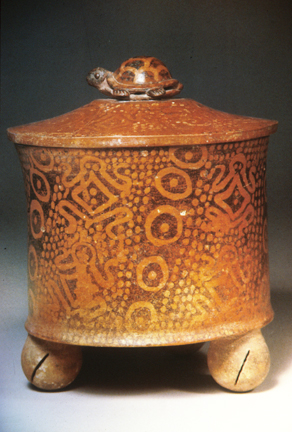
Maya Polychrome Cylinder Lidded form with wax resist design of frogs,
Classic Maya Period, 495-593 CE, Guatemala
ART 198 - HISTORY OF WORLD CERAMICS
| Another form favored by the Maya potter was the lidded container which stood on tripod, ball like feet, a form seen first in Teotihuacan. The pattern on this piece was achieved through the use of a wax resist technique. The clay body color is a terra cotta, and onto this was painted the design in wax. Next the colored slip, made with iron oxide, and a darker color than the clay body, was painted on. It would not adhere to the waxed areas, which would remain and show the lighter body color. The design is jumping frogs and the dots represent rain. Note the turtle atop the lid as a handle. In both Precolumbian and contemporary Maya culture, frogs and turtles symbolize fertility and rain, since they both usually appear as soon as the rains begin. Rain was of utmost importance to the Maya, as with all agricultural societies, for obvious reasons. The Maya areas of the Yucatán and Guatemala have rainy seasons followed by long periods of no rain, and the coming of the rainy season, heralded by the appearance of frogs and turtles was always a time of rejoicing. The Maya developed a very sophisticated system of water storage, using natural hollow in the limestone which forms the Yucatán peninsula. These natural stone depressions, called cenotes, were used to store water during the dry season. The turtle also symbolizes the interface of the heavens and the earth, as noted in a previous slide. So, this piece is laden with symbolism, and may have played a part in a religious ritual for bringing on the rainy season. The hollow tripod legs have small balls of clay fired inside, so the entire pieces would have served as a rattle. | Maya Polychrome Cylinder Lidded form with wax resist design of frogs, Classic Maya Period, 495-593 CE, Guatemala |
|
|